Affiliate disclosure: This post may contain affiliate links. Please see our Privacy Policy.
Breeding new varieties is tricky at best, and garlic has been vegetatively propagated for millennia. Each garlic plant is grown from a clove of a parent plant, effectively creating a clone each generation. But is it possible to breed garlic in your own backyard?
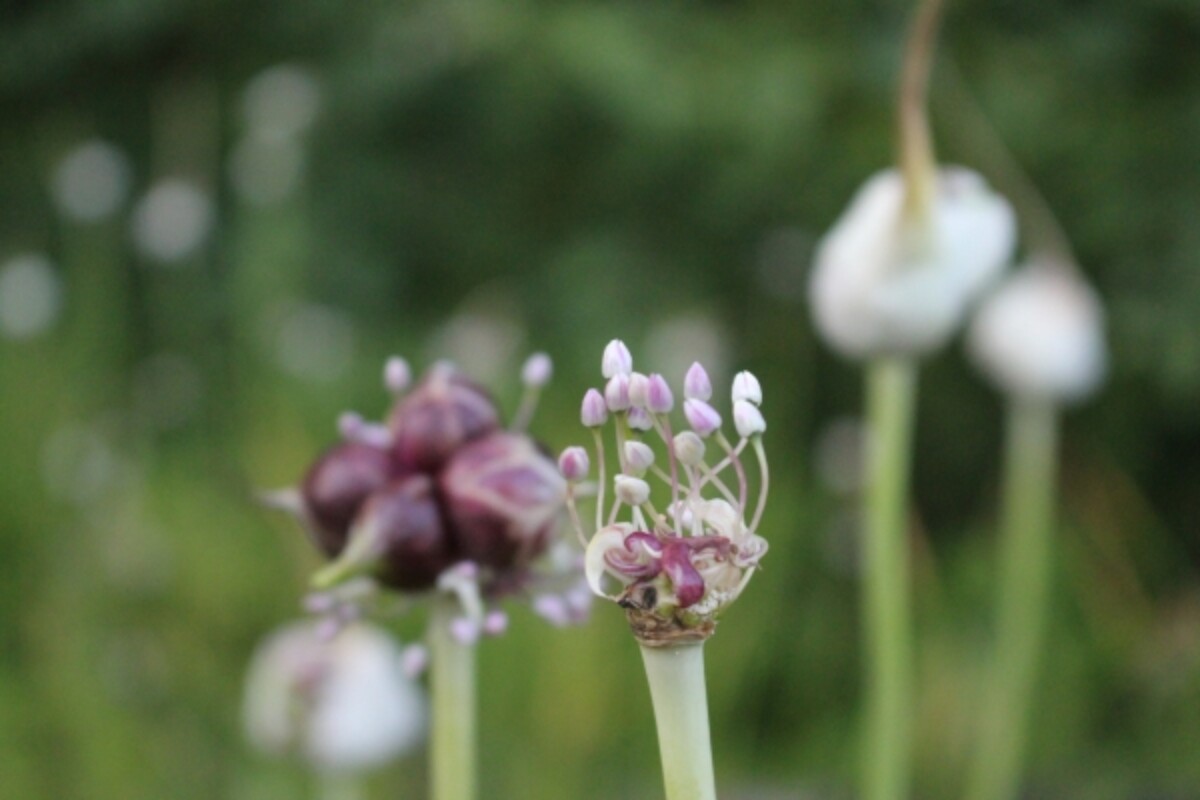
Last winter I spent countless hours pouring over Will Bonsall’s Guide to Radical Self Reliant Gardening. It’s packed with a wealth of gardening, homesteading and permaculture knowledge that I just haven’t found anywhere else.
He’s been out there living the life for decades, and with minimal external inputs. He even grows his own oilseed, and what he can’t grow, he just does without.
It quickly became my all-time favorite homesteading book, and I read it cover to cover at least 3 times over the course of three months.
I marked many pages, but one, in particular, had me irrationally excited. While garlic generally reproduces asexually through division of bulbs, or through topsetting bulbils within the scapes at the top of the main stalk, they do apparently have an additional option for cross-pollination.
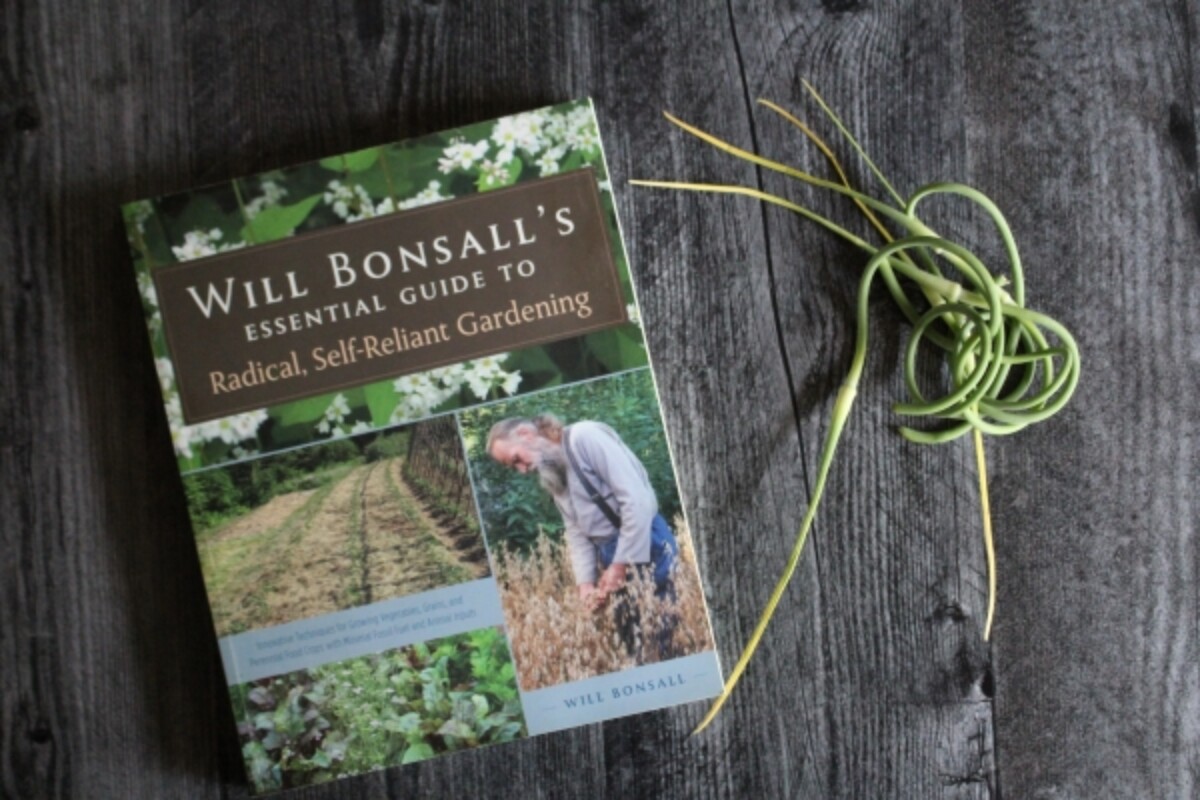
Will Bonsall makes mention of sexually reproducing garlic flowers hiding inside garlic scapes:
“It’s not wholly true that garlic rarely engages in sex. When you look at a cluster of bulbils, especially very early in their formation, you’ll often notice a tiny floret or two scattered among them. These are actually sexual flowers, and might ripen and produce viable seed (of a new variety even), except that they are soon overwhelmed and aborted by developing bulbils around them. If you can spot these sexual and asexual organs when they are first developing and gently excise the nascent bulbils (with a tweezer perhaps, or a very sharp carpet knife) before they can compete, there’s a chance, albeit slight, that some of the sexual flowers may get pollinated and grow to mature seed. Alliums are generally self-sterile, which is probably why the rate of takes is so discouragingly low.”
He goes on to say that he hasn’t actually tried breeding his own garlic seed because as he says, “I have no time for this sort of nonsense; I’m far too occupied as it is. I only urge you to dabble in this, in the hope that you will develop something new to share with me and everyone else.”
I’m not going to pretend that I have a lot of free time, I have two toddlers at home and 30 acres to tend…but the day I can’t dabble in a bit of foolishness to satisfy my curiosity I might as well already be dead. Garlic flowers!?!?! I just had to see them.
We grow a lot of garlic, and harvest scapes by the bucketload in the spring, so leaving a few behind for science is no big deal.
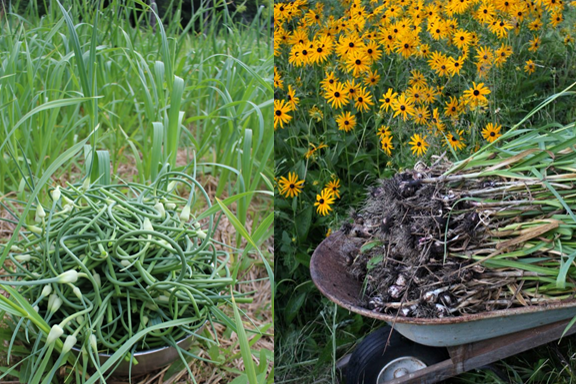
Generally, garlic scapes are removed to encourage the plants to form large bulbs. I often leave the scapes so I can harvest the top setting garlic or garlic bulbils. Until now, I’ve called those “garlic seed” because they can be planted as well.
We plant the bulbils and harvest full-sized garlic 2-3 years later in large perennial garlic patches, and it’s an excellent lazy gardener’s solution to growing garlic. (It also allows you to leave in permanent garlic patches, which helps reduce pests for other plants, especially around fruit trees.)
The one thing I’d never done though, was torn open an actual garlic scape early on in its developement. There are tiny flowers in there? Really?!?!?
Breeding your own garlic isn’t exactly all that practical, but I’m a huge nerd, and I desperately wanted to see garlic flowers. It’s completely irrational, but I just couldn’t wait. It’s like a secret treasure that’s been hiding in there all along.
I’ve been planting garlic for a decade, and I’ve seen thousands of scapes…but never once have I laid my eyes on a garlic flower.
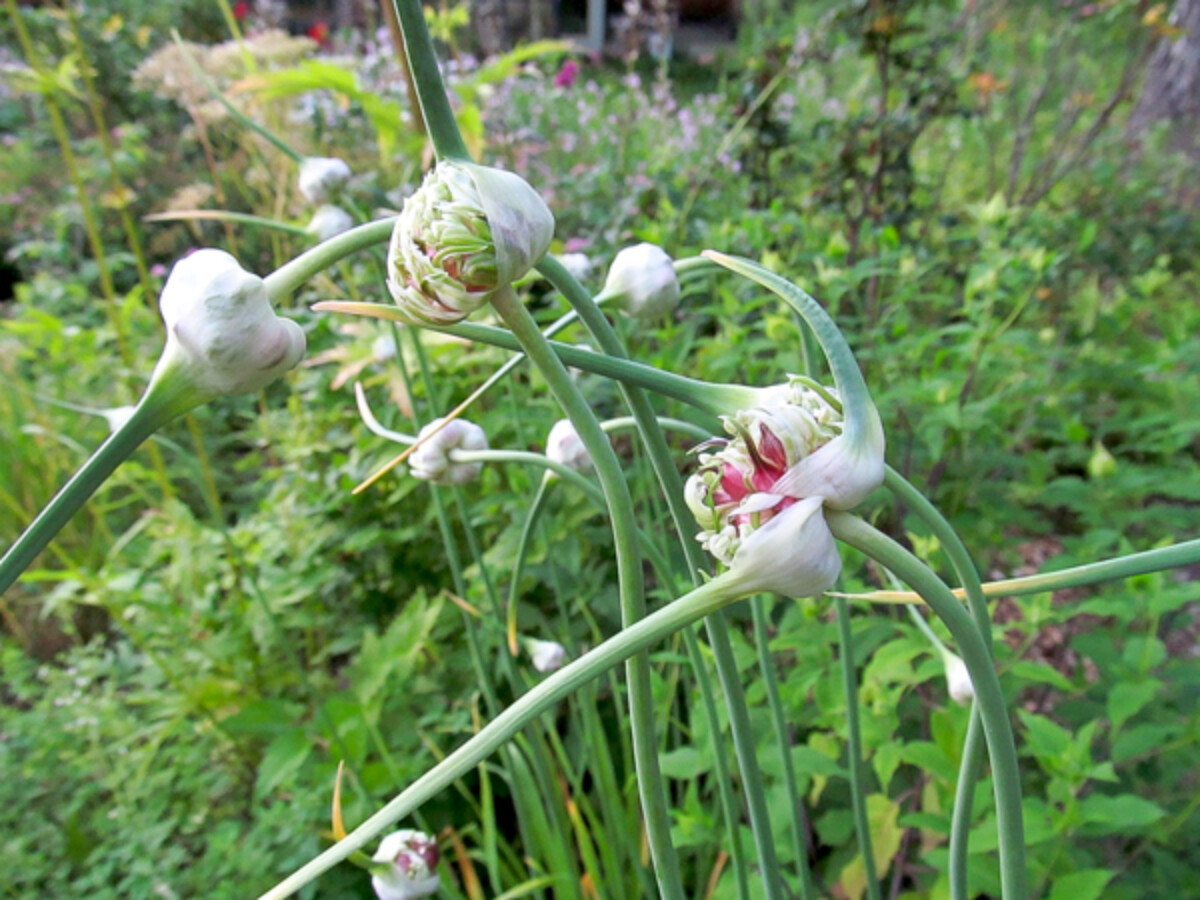
The following spring I waited eagerly for garlic scapes, and I began tearing them open as soon as the first ones formed.
In the very early immature stages, I could see tiny flower buds forming within the scapes, but they were so tiny and delicate that any contact broke them. Beyond that, it seems that the flowers develop before the bulbils, so I didn’t actually see any bulbils to remove at this stage.
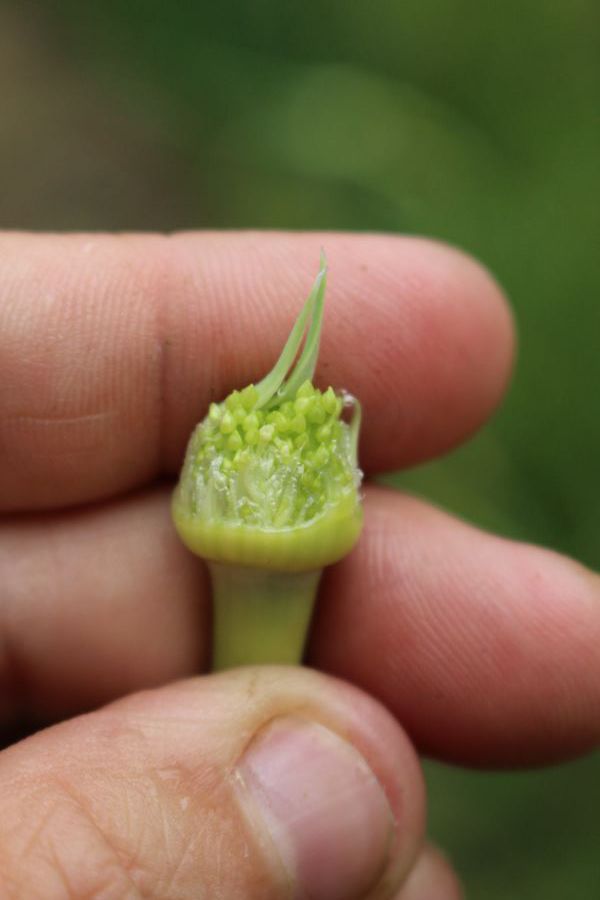
I waited a few more weeks for the bulbils to begin forming, and then I was able to see both bulbils and garlic flowers together in the same scape.
With careful hands, I gently remove the tiny bulbils, leaving just the small purple garlic flowers.
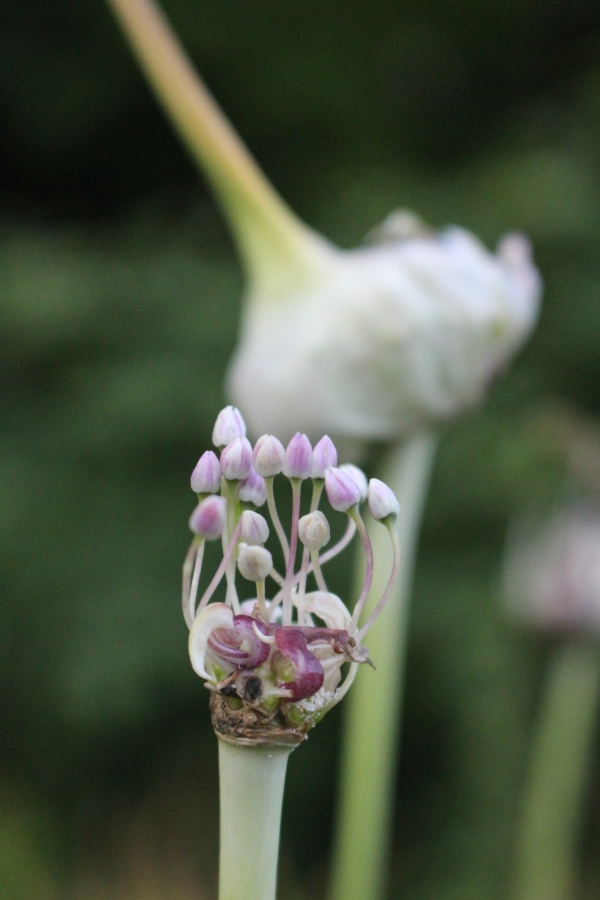
In playing around with all these garlic scapes, I have to say I was most impressed by the sheer variation between the scapes, bulbils, and flowers of different garlic varieties.
Some had just a handful of flowers and bulbils, while others had what looked like a hundred bulbils and dozens of tiny flowers.

They looked like closed tulips, and I checked back every day waiting for them to open. I expected to have to hand pollinate them with a tiny paintbrush since Will notes that alliums are often self-sterile.
The problem is, those little flowers never opened. They stayed tightly closed well into the fall, and then dried off into nothingness.
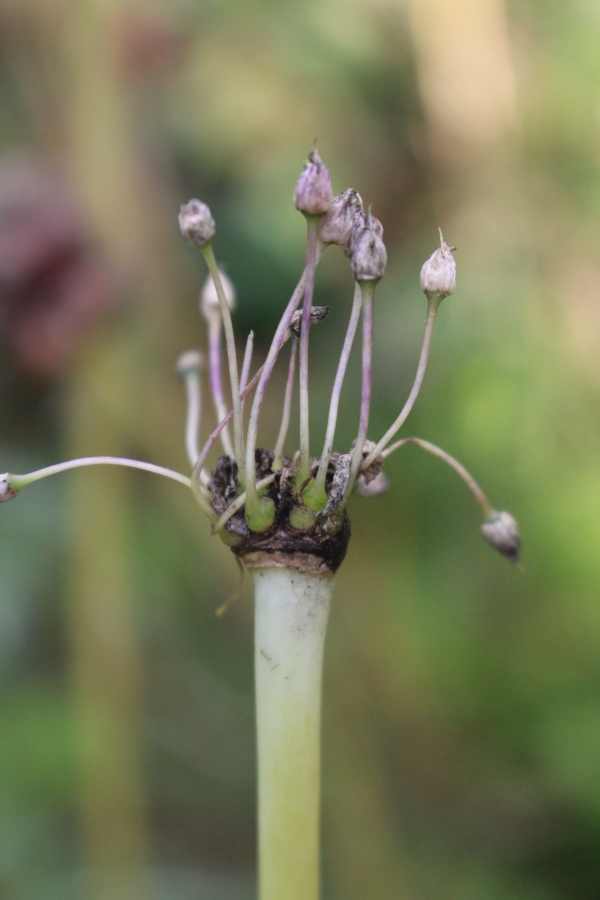
After my lack of success last year, I did a bit more research and found someone that has actually produced true garlic seed by sexual reproduction. This article describes the process, and though he did remove the bulbils, he didn’t have to open the flowers or hand pollinate.
Here are his pictures of his garlic flowers and true garlic seed:

I’m determined to try again this year, and perhaps gently open the flowers by hand if necessary.
If you happen to have time for this type of foolishness, I’d welcome you to follow along with the garlic seed fun. Let me know if you’re successful!
More Garlic Growing Articles
Looking for more posts about garlic?
- Growing Garlic as a Perennial
- Planting Garlic from Seed (Garlic Bulbils)
- Planting Garlic in the Fall
- Garlic Varieties for the Home Garden
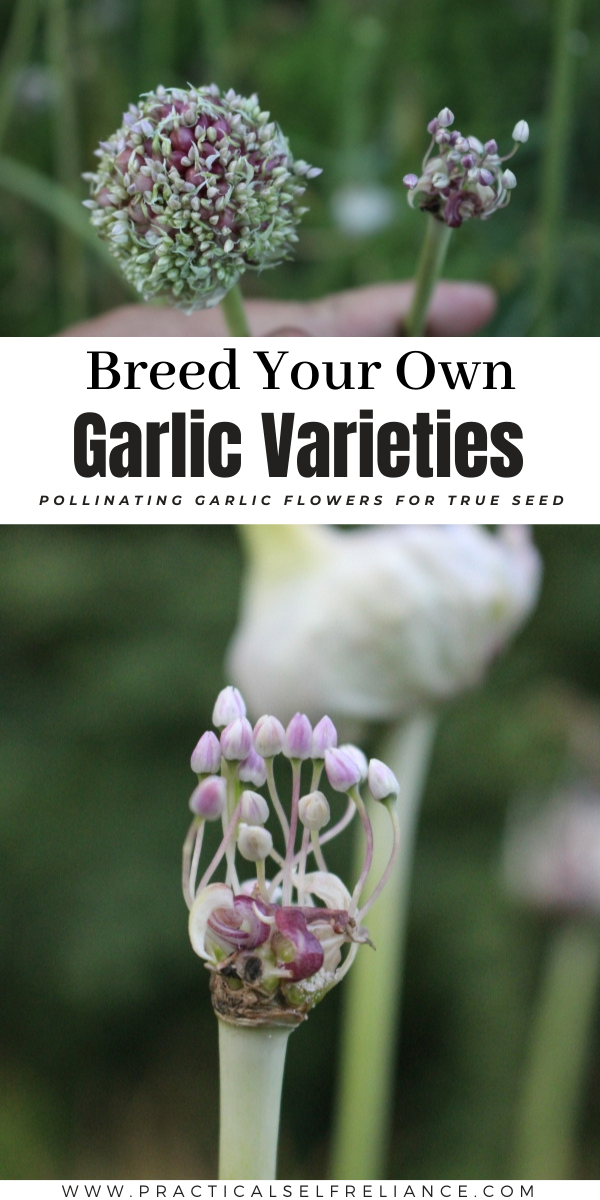














G’Day from the Eastern seaboard of Australia,
My garlic flowers were more of an azure.
I did hand pollinate by gently cupping my hand over the flowers and rolling my hand to distribute.
As I had two flowers, I’d do a session of alternating from one to the other so Flower A could pollinate Flower B, visa versa.
My flowers didn’t form any bulbils and I think I might know why …
My flowers were the result of re-sprouting garlic scraps, similar to how one would do so with an onion base or a leek base.
Yes, it can be done, and it was lots of fun. Well, I thought it was lots of fun.
What can I say. I’m a fmr research biologist who looked at a garlic clove and thought “I wonder what would happen if —”
Anyways, that’s a ramble for another time. On with the TGS experience (thus far)
My azure toned flowers did produce about sixty-ish (60-ish) seeds combined that had the appearance of allium seeds – black and wedge shape with three (3) seeds per fruit (seed pod).
I allowed the fruits to dry out on the plant and sowed the seeds as one would an onion seed – on a surface of seedling potting mix and with a light dried on the cob corn-silk mulch layer.
From the initial sixty-ish (60-ish) seeds two (2) germinated, and one (1) survived through the winter just finished (Aussie Aussie Aussie). The second may have perished due to my handling when trying to transplant. Next time I’ll leave in place until the infant plant is stronger or I will sow in place.
Baby Garlic Winter Novella 2024 early development so far is like this:
Infant plant was transferred into a large “permanent” terracotta pot filled with mushroom compost and dried corn silk as an initial mulching layer. I want minimal root disturbance and for her to “age in place” through to full maturity.
Initial germinal blade (my terminology) stayed to about 2-2.5cm (approx 2.5cm/1 inch) and as a single until blade #2.
Blade #2 appeared after about 4 (?) weeks.
Blades #1 – #4 all developed with a cylindrical shape (not a tube like an onion).
When blade #3 emerged Blade #1 died off soon afterwards, and when Blade #4 emerged then blade #2 died off, and when blade #5 emerged blade #3 died off. I’m starting to suspect a trend.
Currently baby Garlic Winter Novella 2024 (not to be confused with my baby Rose Winter Novella 2024 and baby Rose Novella Spring 2024 – surprise sibling) is about 7.5cm tall.
Blade #5 (emerged 18 days ago) while initially looking like it would also have a cylindrical shape has flattened out to a more typical leaf shape for a garlic plant.
Blade #6 emergence was noticed today, and the very tip of blade #4 had just started to yellow yesterday.
All up this seedling is probably 6mo from germination.
They seem to be a very slow growing plant but that may be an artefact of an autumn sowing and germination in an Australian “cool climate”. Recently we relocated to the sub-tropics, and so far Garlic Novella is doing well, even in full Australian sub-tropical mid-spring sunshine.
(If you know anything about the Australian sun, Northern hemisphere “full sun” plants really need some partial shade in mainland Australia. She really flexes that solar radiation muscle in this area of the Southern Hemisphere).
She’s still in her home mushroom compost terracotta pot (fits beautifully into a bucket for easy transport) and is enjoying a recent addition of sugar cane mulch for – well – mulch.
I definitely encourage those who can to try raising a novel garlic from true garlic seed (TGS).
As much as possible and as often as possible.
It’s a way to keep garlic biodiversity going because monoclonal crops are very susceptible to being wiped out quickly should a disease/pathogen emerge that feasts upon them. Just ask the banana and kiwi fruit industries.
Garlic as a culinary crop can only remain viable if homesteaders, hobbyists, and generally curious people keep breeding novel varieties just for the love, calling, or passion of it.
Yes, I have been taking images and videos about this experience and might publish the journey one day.
Which reminds me, I have to take photos of Garlic Novella Winter 2024 to show off to my sister and my bestie.
Encourage and enjoy
Bless
I’m actually playing with wild garlic this year, so that’s amazing information, who would of known. I’m going to check bubils right now. Thanks for sharing!
You’re very welcome.
Wow! Fascinating. Definitely going to try this.
Im interested in connecting off line about clay in vt. Ive been doing deep research about clay in VT, I live in Putney. Also a long term naturalist and deep nature kin.
I’ve been working on True Garlic Seed for a few years now. I was able to get a few seeds from one variety, but they were not viable. I think people have had more success with the purple stripe varieties. I was able to get in contact and get some seeds from two sources and grow some out this year. I got about 250 seeds and was able to get about 25-30 to sprout. Then the squirrels decided to dig out all of my pots one day. I saved 14 small plants that I have under lights inside right now. If you want someplace with on long ongoing discussion of True Garlic Seed check out this forum: https://alanbishop.proboards.com/thread/5471/true-garlic-seed . Since you link to Joseph lofthouse’s website you probably already have seen that forum. Best of luck and if we both have some seeds at some point down the road maybe with can swap some.
Thank you, I hadn’t seen that discussion page, I’ll check it out. Let me know how your garlic seeds turn out once they’re full plants, I’m excited to know!
Sure thing, my first chance at seed with them will still be another year away. When I got seed I use a small paint brush to move pollen from plant to plant. Your best bet is probably to use several varieties that have flowers that open at the same time and cross pollinate them. Some pages say to remove the scapes and place in water, but I had better luck leaving them on the plant. I’ll probably post on the True Garlic Seed forum page I post with updates on my garlic. Good Luck.
Ashley, your articles are always interesting! So this year instead of eating up my scapes I shall try to establish a perennial bed as you suggested.
As an FYI I found that if you forget some scapes beyond eating stage they make a great bug repellant if you blend them in some water and dish soap. Just don’t use your beloved’s favorite blender…. Now that ones mine and I bought her an early Christmas Present.
Awesome, good to know!